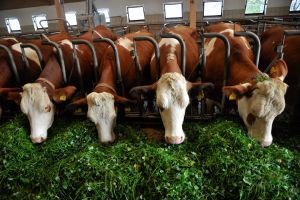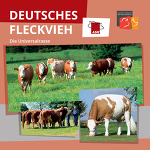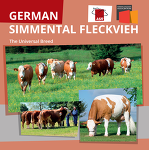German Fleckvieh (Simmental)
German Fleckvieh is a dual-purpose breed with a high level of fitness and performance, which is particularly widespread in southern Germany. The optimal Fleckvieh cow in milk production has a strong forehand and still has back and haunch muscling necessary for the stability and health of the animal, even at lactation peak. Fleckvieh animals are characterised by a stable foundation. The udder is firmly attached and has a level udder floor which is still above the hock even after several lactations. The rump is broad and slightly sloping. The adult Fleckvieh cow in dairy production has a height at sacrum of 140cm - 150cm with a weight of 650kg to 850kg. Depending on management and natural conditions, herd yields of 7,000kg milk with 4.2% fat and 3.7% protein can be realised as well as performance levels of up to 10,000kg milk, depending on feeding intensity. The average milk production of the herdbook cows in 2019 is around 7,900kg with about 4.13% fat and 3.50% protein. The annual milk production increases up to the 5th lactation. The aim is to increase the longevity with a lifetime production of more than 30,000kg milk. A remarkable feature of the breed is the top position in udder health with an average cell count of about 180,000 cells over all lactations. The age at first calving is between 26 and 28 months, the calving interval is about 390 days. Well-growing male calves are ideally suited for successful cattle fattening and are an important source of additional income for the specialised milk producer. In the intensive fattening of the young bulls, average daily gains of over 1,300g are achieved. Carcass quality: 85% to 90% of the slaughter bulls are classified in the commercial classes E and U desired by the market, with a slaughter yield of 57% - 60%. Cows for slaughter reach a carcass weight of 350kg - 450kg. The demanded carcasses are predominantly classified in commercial classes U and R and show medium fatness with best marbling.
The breeding goal, which is aimed at the sustainable improvement of profitability and product quality, is defined with reference to the described breed profile by the total economic breeding value. The milk, meat and fitness traits are in a balanced economic relationship. The individual traits are weighted according to their economic importance at farm level.
Further information on the German Fleckvieh breed can be found on the ASR website.













